The AMD Zen and Ryzen 7 Review: A Deep Dive on 1800X, 1700X and 1700
by Ian Cutress on March 2, 2017 9:00 AM ESTBenchmarking Performance: CPU System Tests
Our first set of tests is our general system tests. These set of tests are meant to emulate more about what people usually do on a system, like opening large files or processing small stacks of data. This is a bit different to our office testing, which uses more industry standard benchmarks, and a few of the benchmarks here are relatively new and different.
PDF Opening
First up is a self-penned test using a monstrous PDF we once received in advance of attending an event. While the PDF was only a single page, it had so many high-quality layers embedded it was taking north of 15 seconds to open and to gain control on the mid-range notebook I was using at the time. This put it as a great candidate for our 'let's open an obnoxious PDF' test. Here we use Adobe Reader DC, and disable all the update functionality within. The benchmark sets the screen to 1080p, opens the PDF to in fit-to-screen mode, and measures the time from sending the command to open the PDF until it is fully displayed and the user can take control of the software again. The test is repeated ten times, and the average time taken. Results are in milliseconds.
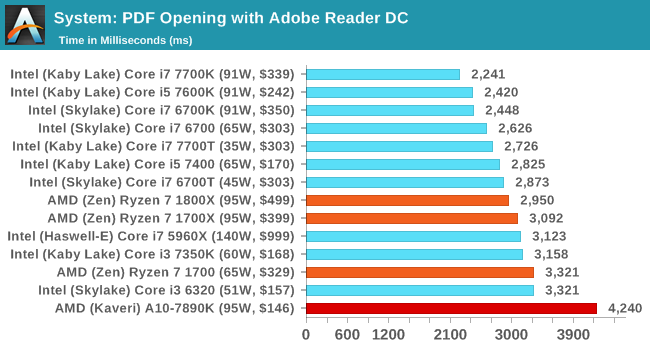
FCAT Processing
One of the more interesting workloads that has crossed our desks in recent quarters is FCAT - the tool we use to measure stuttering in gaming due to dropped or runt frames. The FCAT process requires enabling a color-based overlay onto a game, recording the gameplay, and then parsing the video file through the analysis software. The software is mostly single-threaded, however because the video is basically in a raw format, the file size is large and requires moving a lot of data around. For our test, we take a 90-second clip of the Rise of the Tomb Raider benchmark running on a GTX 980 Ti at 1440p, which comes in around 21 GB, and measure the time it takes to process through the visual analysis tool.
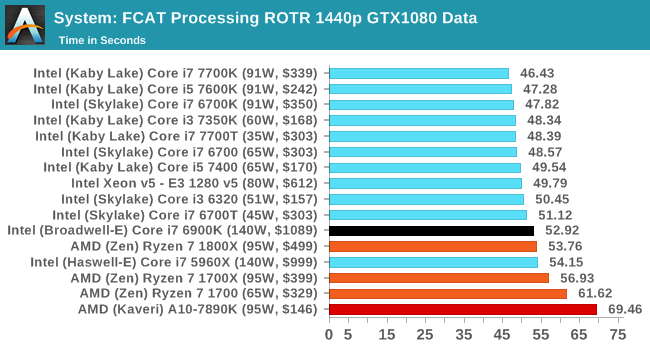
3D Particle Movement v2.1
This is the latest version of the self-penned 3DPM benchmark. The goal of 3DPM is to simulate semi-optimized scientific algorithms taken directly from my doctorate thesis. Version 2.1 improves over 2.0 by passing the main particle structs by reference rather than by value, and decreasing the amount of double->float->double recasts the compiler was adding in. It affords a ~25% speed-up over v2.0, which means new data.
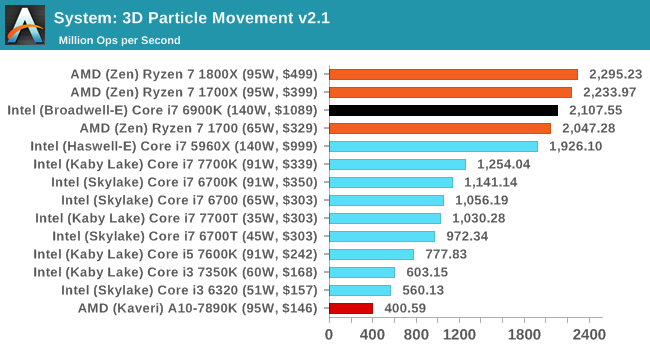
DigiCortex 1.16
Despite being a couple of years old, the DigiCortex software is a pet project for the visualization of neuron and synapse activity in the brain. The software comes with a variety of benchmark modes, and we take the small benchmark which runs a 32k neuron/1.8B synapse simulation. The results on the output are given as a fraction of whether the system can simulate in real-time, so anything above a value of one is suitable for real-time work. The benchmark offers a 'no firing synapse' mode, which in essence detects DRAM and bus speed, however we take the firing mode which adds CPU work with every firing.
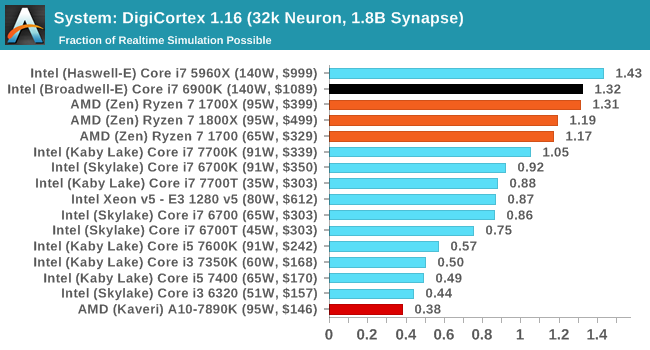
Agisoft Photoscan 1.0
Photoscan stays in our benchmark suite from the previous version, however now we are running on Windows 10 so features such as Speed Shift on the latest processors come into play. The concept of Photoscan is translating many 2D images into a 3D model - so the more detailed the images, and the more you have, the better the model. The algorithm has four stages, some single threaded and some multi-threaded, along with some cache/memory dependency in there as well. For some of the more variable threaded workload, features such as Speed Shift and XFR will be able to take advantage of CPU stalls or downtime, giving sizeable speedups on newer microarchitectures.

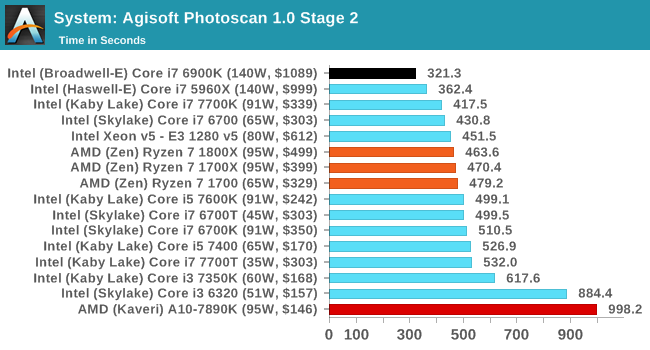
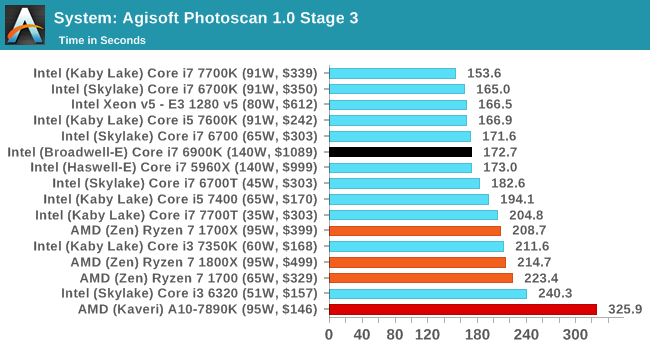
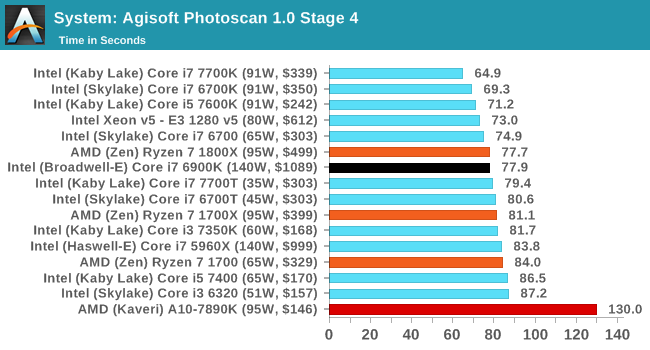
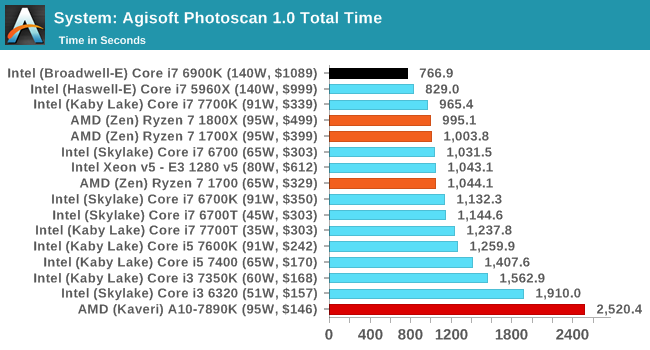










574 Comments
View All Comments
BurntMyBacon - Friday, March 3, 2017 - link
@ShieTar: "Well, the point of low-resolution testing is, that at normal resolutions you will always be GPU-restricted."If this statement is accepted as true, then by deduction, for people playing at normal (or high) resolutions, gaming is not a differentiator and therefore unimportant to the CPU selection process. If gaming is your only criteria for CPU selection, then that means you can get the cheapest CPU possible until you are not GPU restricted.
@ShieTar: "The most interesting question will be how Ryzen performs on those few modern games which manage to be CPU-restricted even in relevant resolutions, e.g. Battlefield 1 Multiplayer."
I agree here fully. Show CPU heavy titles to tease out the difference between CPUs. Artificially low resolutions are academic at best. That said, according to Steam Surveys, just over half of their respondents are playing at resolutions less than 1080P. Over a third are playing at 1366x768 or less. Though, I suspect the overlap between people playing at these resolutions and people using high end processors is pretty small.
Average frame rate is fairly uninteresting in most games for high end CPUs, due to being GPU bound or using unrealistic settings. Some, more interesting, metrics are min frame rate, frame time distribution (or simply graph it), frame time consistency, and similar. These metrics do more to show how different CPUs will change the experience for the player in a configuration the player is more likely to use.
Lord-Bryan - Thursday, March 2, 2017 - link
Who buys a 500 dollar cpu to play games at 720p res. All that talk is just BS.JMB1897 - Friday, March 3, 2017 - link
That test is not done for real world testing reasons. At that low resolution, you're not GPU bound, you're CPU bound. That's why the test exists.Now advance a few years into the future when you still have your $500 Ryzen 7 CPU and a brand new GPU - you may suddenly become CPU bound even at QHD or 4k, whereas a 7700k might not quite be CPU bound just yet.
MAC001010 - Saturday, March 4, 2017 - link
Or a few years in the future (when you get your new GPU) you find that games have become more demanding but better multi-threaded, in which case your Ryzen 7 CPU works fine and the 7700k has become a bottleneck despite its high single-threaded performance.This illustrates the inherent difficulty of comparing high freq. CPUs to high core count CPUs in regards to future potential performance.
cmdrdredd - Saturday, March 4, 2017 - link
"Or a few years in the future (when you get your new GPU) you find that games have become more demanding but better multi-threaded, in which case your Ryzen 7 CPU works fine and the 7700k has become a bottleneck despite its high single-threaded performance."Maybe, the overclocking scenario is also important. Most gamers will overclock to get a bit of a boost. I have yet to replace my 4.5Ghz 3570k even though new CPUs offer more raw performance, the need hasn't been there yet.
One other interesting thing is how Microsoft's PlayReady 3.0 will be supported for 4k HDR video content protection. So far I know Kaby Lake supports it, but haven't heard about any of AMD's offerings unless I missed it somewhere.
Cooe - Sunday, February 28, 2021 - link
Lol, except here in reality the EXACT OPPOSITE thing happened. A 6-core/12-thread Ryzen 5 1600 still holds up GREAT in modern titles/game engines thanks to the massive advantage in extra CPU threads. A 4c/4t i5-7600K otoh? Nowadays it performs absolutely freaking TERRIBLY!!!basha - Thursday, March 2, 2017 - link
all the reviews i read are using NVidia 1080 gfx card. my understanding is AMD graphics has better implementation of DX12 with ability to use multiple cores. I would like to see benchmarks with something like RX480 crosfire with 1700x. this would be in the similar budget as i7 7700 + GTX 1080.Notmyusualid - Friday, March 3, 2017 - link
http://www.gamersnexus.net/hwreviews/2822-amd-ryze...cmdrdredd - Saturday, March 4, 2017 - link
Overclocking will be interesting. I don't use my PC for much besides gaming and lately it hasn't been a lot of that either due to lack of compelling titles. However, I would still be interested in seeing what it can offer here too for whenever I finally break down and decide I need to replace my 3570k @ 4.5Ghz.Midwayman - Thursday, March 2, 2017 - link
Here's hoping the 1600x hits the same gaming benches as the 1800x when OC'd. $500 for the 1800x is fine, Its just not the best value for gaming. Just like the i5's having been better value gaming systems in the past.